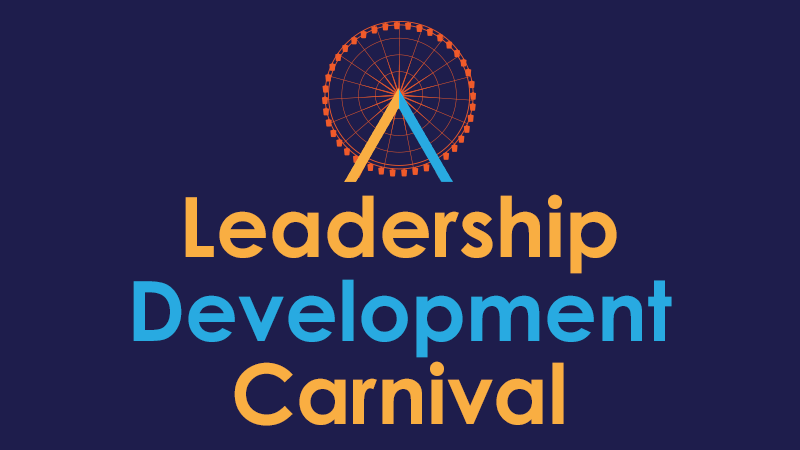We are thrilled to be hosting the July Leadership Development Carnival. We participate monthly and find it is always filled with great insight for leaders to read and share.
Communication
Psychological Safety: Pro Tips for Leaders
As a leader, how intentional are you about creating psychological safety for your team? Check out these tips from the experts to help you build rapport and increase communication with your team. — Jennifer Miller (@JenniferVMiller)
Conflict itself is born from a perspective that we must make either-or decisions; that we can’t have more than one option; that two different things cannot co-exist. In these situations, the result is generally less favorable than if the parties explored & solutions. Focusing on & requires a commitment to exploring mutually beneficial results, not necessarily the same results. — Priscilla Archangel (@PrisArchangel)
When is Workplace Gossip a GOOD Thing – and when it isn’t, HOW do you Fix it?
As someone who works in a team or leads a team, you have probably heard that gossip is always negative. It should be avoided at all costs…
Gossip is defined by the Oxford dictionary as “Casual or unconstrained conversation about other people.”
And Dave Ramsey, a welll-known financial expert, has been outspoken about the “No-Gossip” policy for his people at Entreleadership – for them it has been a significant part of defining their culture.
However, there is recent research that has shown gossip can actually have positive effects on team morale, culture, and performance. — Sean Glaze (@leadyourteam)
Two-Way Communication: 4 Tips and Examples for Getting It Right
There are many opportunities for leaders to engage employees in meaningful two-way communication. Mastering it helps build a stronger company culture, among many other benefits. Explore these tips and methods known to be effective. — David Grossman (@ThoughtPartner)
Tips for Overriding the Worst Communication Habit
We often pride ourselves on knowing what people think without fully listening. Overcoming this habit is critical to good communication and creating better relationships. — Marcia Reynolds (@marciareynolds)
Do We Ever Really Resolve Conflicts? Try Conflict Management
Are conflicts resolved or managed? Conflict resolution means that a conflict is solved, settled, or finalized. While managing conflict means that the conflict is mediated, handled, and coped with: in short, there is an agreement to disagree yet move forward together on areas in common. Read on to learn how to manage conflicts to success. — Diana Peterson-More (@DianaPMAuthor)
Creativity/Inspiration
Each day offers us a chance to make a difference, to shape the future, and to inspire greatness in others. Let us seize this opportunity with passion, purpose, and unwavering dedication. — Brenda Yoho (@BrendaYoho)
Development
Just Because You Can, Doesn’t Mean You Should
Do you do things because it’s in your best interest, because it looks good, or because it’s right? — Frank Sonnenberg (@FSonnenberg)
Work on a nonviolent, compassionate culture
What if your organizational culture was nonviolent and compassionate? You and your performance would thrive. And so would the company. Here’s inspiration from the research. A nonviolent, compassionate culture helps to build a better world. — Marcella Bremer (@MarcellaBremer)
Four Things to Regularly Assess in Your Business
One of the skills an experienced big mountain backcountry skier practices is testing the snowpack for avalanche risk. “I think it looks good,” won’t cut it. We have to pull out the shovel and test the pack to ensure we can venture down in a safe way. Otherwise, we risk life-threatening conditions and danger. “Where’d he go?”
It’s similar when it comes to your business. You can glide along thinking “I think it looks good,” but without regular testing and evaluating of the conditions, you can end up in an avalanche of trouble.— Jon Verbeck (@jonverbeck1)
Discover the transformative power of courageous leadership. Dive into the essence of courage, embrace vulnerability, and challenge the status quo. Discover practical strategies to inspire others and drive extraordinary results. — Bill Treasurer (@btreasurer)
How to Get Unstuck with Your Career Pivot
In this article, Art Petty provides advice for professionals who are feeling stuck in their current careers and are looking to make a pivot. He offers tips on how to identify your interests and skills, research new career paths, and create a plan for your transition. — Art Petty (@artpetty)
How a Leader’s Well-Meaning Actions Thwart Career Development (Without Even Knowing It)
Leaders often have good intentions when they try to help their employees develop their careers. However, sometimes their well-meaning actions can actually have the opposite effect. This article explores some of the ways that leaders can unwittingly thwart career development, and offers advice on how to avoid these pitfalls. – Julie Winkle Giulioni (@Julie_WG)
Faulty Filters Lead to Empty Funnels: Fundamental Flaws in the Fight for Talent
The truth is that some companies are laying off, some are ramping up hiring and some are doing both. Those that have downsized in the face of economic stress need to “backfill” with qualified internal candidates. Those that are financially healthy or on a growth path, will be looking to “buy” qualified talent from the outside. And recent data suggests that more and more companies are looking to “borrow” qualified talent from the growing independent consultant pool. But whether they are backfilling, buying or borrowing talent, they are all facing the same challenge — finding the most qualified candidates. And how do they do that? My client experiences suggest that they too often use what I call “faulty filters.” — Bev Kaye (@BeverlyLKaye)
Don’t Be a Small-Minded Leader
Leaders who are self-aware and honest about their weaknesses, challenges, and mistakes are less likely to behave in small-minded ways. That’s because they don’t waste time defending their egos and need to be right. — Ken Byler
Job Hunters are Looking for a Values Match
In the post-pandemic world of attracting top candidates, companies are finding that decent salaries and competitive benefits are not enough. Company values are increasingly important to job seekers. — S. Chris Edmonds (@schrisedmonds)
Engagement
The Power of a Customer’s Name: 5 Ways to Use It to Your Advantage
Using a customer’s name is a simple yet powerful way to improve their experience with your business. It’s an effective way to make them feel valued and acknowledged, which can lead to increased loyalty and customer satisfaction.
When a customer hears their name, it creates a sense of familiarity and personalization. It makes them feel like they’re more than just another faceless customer, and that you appreciate their business. By using the power of a customer’s name, you can also build rapport and establish a connection, which can lead to better communication and understanding between the customer and your team. — Steve DiGioia (@stevedigioia)
Should I Quit This Workplace Conflict: How to Know When It’s Time to Leave
One of the heartbreaking findings in the World Workplace Conflict and Collaboration Survey was the number of people who said if they were faced with this workplace conflict again, they would quit, or quit sooner. Here are a few powerful questions to help you decide. — Karin Hurt & David Dye (@letsgrowleaders)
Thank goodness it didn’t take long for me to shift my perspective and see the way that my Horizon Point Team members valued connection as much as I did. According to Gallup analysis, “it finds that engagement has 3.8x as much influence on employee stress as work location.” — Emily Addison (@emaaddisonhpc)
Ethics and Policy
The Gender Wealth Gap: The Pay Gap Reframed
Leaders seeking greater equity in the workplace need to understand the broader implications of the pay gap for women and under-represented leaders more broadly. Unequal pay leads to more than short term disadvantage for the employee and their family, but a lifelong financial deficit, which can become a generational burden. — Dana Theus (@DanaTheus)
Leader Evaluation
How Do You Measure Your Worth as a Leader?
It’s much easier to measure the effectiveness of leaders by looking at their quantifiable deliverables—monthly sales targets, net promoter scores, business objectives met, on-time deadlines, projects completed. While those are all critical, truly exceptional leaders also perform at high levels with skills that aren’t directly tied to tangible outcomes. This article covers some additional measuring sticks for evaluating your true impact and worthiness as a leader. — Sara Canaday (@saracanaday)
Leadership
Four Reasons Why Flexing Your Leadership Style Builds Trust
Most managers are one-trick ponies, meaning they default to using a single leadership style in all situations. Randy Conley shares how flexing your leadership style to match the situation builds trust and positive relationships with your people. — Randy Conley (@RandyConley)
Problem Solving
Critical thinking starts with questions and examining assumptions. — Wally Bock (@WallyBock)
Productivity
The beauty of going slow to go fast – and how to do it
Lisa Kohn of Thoughtful Leaders Blog presents The beauty of going slow to go fast – and how to do it where she shares that while it may seem counterintuitive to slow down and take pauses when your to do list seems to have a mind of its own and overwhelm is a constant state, it’s often exactly what we need. It’s not always an easy shift. But it is possible. — Lisa Kohn (@ThoughtfulLdrs)
Thanks for joining us for this month’s Leadership Development Carnival. We hope that you enjoyed it!



